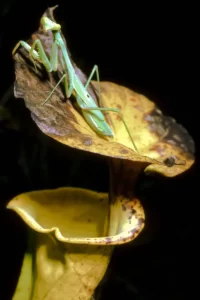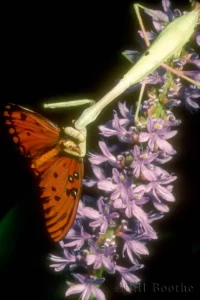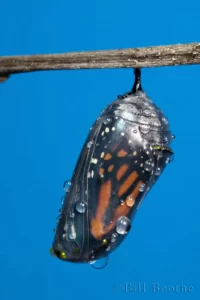One of the benefits of having a yard full of native plants is that you can easily observe the life histories of many insects including butterflies.
Many years ago, while walking through our yard, I spotted a monarch caterpillar hanging upside down from the leaf of a Fireflag (Thalia geniculata). It had already fastened its cremaster to the leaf and was in a “J” position. This position is characteristic of many butterfly species when almost ready to shed the final skin to reveal the chrysalis.
My wife and I ran inside to get our cameras to capture the event. I took a few quick shots (with a film camera then) and set up my tripod in anticipation of getting some really good images of the “change.” I knew it would be quite a while before the monarch shed her skin so I went about other business and checked every fifteen minutes or so to monitor the caterpillar’s progress and take a few additional photos. It was about 11:30 a.m. when we first saw the caterpillar and by 2:30 p.m., we could see that the outer skin was getting more wrinkled, a sign that it would not be much longer. This is when I made my critical mistake: rather than sitting there for the next three hours, I thought I could leave and just check the status every five minutes or so. I last checked it at 2:45 p.m. with no visible changes. Fortunately my wife was also checking its progress and by 2:50 p.m., the skin was already beginning to split to reveal the newly transformed chrysalis. She had her digital camera set up as well and began snapping photos while screaming to me, “Get out here! It’s changing!” Neither of us actually photographed the moments before the skin split to reveal the green chrysalis.
Watch another video of a monarch butterfly emerging from its chrysalis in The Monarch Butterfly: Emerging from Its Chrysalis.
One year, I was determined to capture the metamorphosis. I placed several big fat caterpillars that were feeding on our non-native Scarlet Milkweed (Asclepias curassavica) inside a rearing cage in my studio. I waited and watched as they fed steadily on an unending supply of milkweed. Late one evening, I could tell one of the caterpillars was getting very lethargic and was preparing to change. (These events always seem to happen at inconvenient times.) I already had set up the camera on tripod, lighting, and background. I stayed up past midnight waiting to see if anything was going to happen. I finally went to bed, realizing that I might miss the moment again, but I had more caterpillars to work with. Luckily, the excitement didn’t really start until 11:00 a.m. or so the next day.
Most of the day, it seemed to me that there was little movement, but the images reveal otherwise. If I had to leave even for a second, my wife sat at the camera ready to trip the shutter. And of course, during one of my absences, my wife saw the caterpillar’s skin begin to split. This time though, she kept snapping the shutter while yelling for me to get back. This time we didn’t miss anything.
How the Video Was Made
This two-minute video is a series of over 600 still images that I took with my digital camera from 11:00 a.m. until 10:30 p.m. I did not have the camera automatically take a shot every few minutes, but manually tripped the shutter after focusing for each shot. I did this manually because, as you see in the video, the monarch caterpillar is continuously moving about while trying to shed its skin.
After importing the images into Lightroom, our current photo catalogue program, we adjusted the white point based on a gray card used in one of the shots and adjusted the exposure as needed to balance all the shots. The photos were exported to Photoshop where the images were auto-aligned to compensate for any shifting of the tripod. These images were then imported into a video program. Each image plays for 0.3 second.
Learn More about Butterfly Metamorphosis
In the Company of Wild Butterflies is a 45-minute educational video that was on the American Library Association’s Ten Best Environmental Videos of 2006-2007. It has excellent video segments explaining what is actually happening during a butterfly’s metamorphosis form caterpillar to adult.



